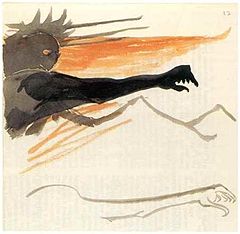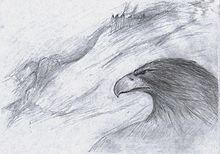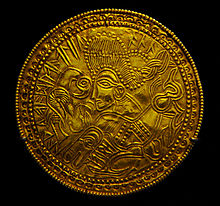Radagast the Brown is a fictional character in J. R. R. Tolkien's legendarium. A wizard and associate of Gandalf, he appears briefly in The Hobbit, The Lord of the Rings, The Silmarillion, and Unfinished Tales.
Eärendil the Mariner and his wife Elwing are characters in J. R. R. Tolkien's Middle-earth legendarium. They are depicted in The Silmarillion as Half-elven, the children of Men and Elves. He is a great seafarer who, on his brow, carried the morning star, a jewel called a Silmaril, across the sky. The jewel had been saved by Elwing from the destruction of the Havens of Sirion. The morning star and the Silmarils are elements of the symbolism of light, for divine creativity, continually splintered as history progresses. Tolkien took Eärendil's name from the Old English name Earendel, found in the poem Crist A, which hailed him as "brightest of angels"; this was the beginning of Tolkien's Middle-earth mythology. Elwing is the granddaughter of Lúthien and Beren, and is descended from Melian the Maia. Through their progeny, Eärendil and Elwing became the ancestors of the Númenorean, and later Dúnedain, royal bloodline.
Glorfindel is a fictional character in J. R. R. Tolkien's Middle-earth legendarium. He is a member of the Noldor, one of the three groups of the Calaquendi or High Elves. The character and his name, which means "blond" or "golden-haired", were among the first created for what would become part of his Middle-earth legendarium in 1916–17, beginning with the initial draft of The Fall of Gondolin. His name indicates his hair as a mark of his distinction, as the Noldor were generally dark-haired. A character of the same name appears in the first book of The Lord of the Rings, The Fellowship of the Ring, which takes place in Middle-earth's Third Age. Within the story, he is depicted as a powerful Elf-lord who could withstand the Nazgûl, wraith-like servants of Sauron, and holds his own against some of them single-handedly. Glorfindel and a version of the story of the Fall of Gondolin appear in The Silmarillion, posthumously published in 1977.
A Balrog is a powerful fictional demonic monster in J. R. R. Tolkien's Middle-earth. One first appeared in print in his high fantasy novel The Lord of the Rings, where the Fellowship of the Ring encounter a Balrog known as Durin's Bane in the Mines of Moria. Balrogs appear also in Tolkien's The Silmarillion and other posthumously published books. Balrogs are tall and menacing beings who can shroud themselves in fire, darkness, and shadow. They are armed with fiery whips "of many thongs", and occasionally use long swords.
Valinor or the Blessed Realms is a fictional location in J. R. R. Tolkien's legendarium, the home of the immortal Valar on the continent of Aman, far to the west of Middle-earth; he used the name Aman mainly to mean Valinor. It included Eldamar, the land of the Elves, who as immortals were permitted to live in Valinor.

Fëanor is a fictional character from J. R. R. Tolkien's legendarium who plays an important part in The Silmarillion as the creator of the three Silmarils, the skilfully-forged jewels that give the book their name and theme. He was the eldest son of Finwë, the King of the Noldor, and his first wife Míriel Serindë.
Tuor Eladar and Idril Celebrindal are fictional characters from J. R. R. Tolkien's Middle-earth legendarium. They are the parents of Eärendil the Mariner and grandparents of Elrond Half-elven: through their progeny, they became the ancestors of the Númenoreans and of the King of the Reunited Kingdom Aragorn Elessar. Both characters play a pivotal role in The Fall of Gondolin, one of Tolkien's earliest stories which formed the basis for a section in his later work, The Silmarillion, and later expanded and released as a standalone publication in 2018.
Húrin is a fictional character in the Middle-earth legendarium of J. R. R. Tolkien. He is introduced in The Silmarillion as a hero of Men during the First Age, said to be the greatest warrior of both the Edain and all the other Men in Middle-earth.

In J. R. R. Tolkien's legendarium, the history of Arda, also called the history of Middle-earth, began when the Ainur entered Arda, following the creation events in the Ainulindalë and long ages of labour throughout Eä, the fictional universe. Time from that point was measured using Valian Years, though the subsequent history of Arda was divided into three time periods using different years, known as the Years of the Lamps, the Years of the Trees and the Years of the Sun. A separate, overlapping chronology divides the history into 'Ages of the Children of Ilúvatar'. The first such Age began with the Awakening of the Elves during the Years of the Trees and continued for the first six centuries of the Years of the Sun. All the subsequent Ages took place during the Years of the Sun. Most Middle-earth stories take place in the first three Ages of the Children of Ilúvatar.
Weapons and armour of Middle-earth are those of J. R. R. Tolkien's Middle-earth fantasy writings, such as The Hobbit, The Lord of the Rings and The Silmarillion.
The fictional races and peoples that appear in J. R. R. Tolkien's fantasy world of Middle-earth include the seven listed in Appendix F of The Lord of the Rings: Elves, Men, Dwarves, Hobbits, Ents, Orcs and Trolls, as well as spirits such as the Valar and Maiar. Other beings of Middle-earth are of unclear nature such as Tom Bombadil and his wife Goldberry.
J. R. R. Tolkien's Middle-earth legendarium features dragons closely based on those of European legend.
The cosmology of J. R. R. Tolkien's legendarium combines aspects of Christian theology and metaphysics, mythology and pre-modern cosmological concepts in the flat Earth paradigm with the modern spherical Earth view of the Solar System.

Saruman, also called Saruman the White, is a fictional character of J. R. R. Tolkien's fantasy novel The Lord of the Rings. He is leader of the Istari, wizards sent to Middle-earth in human form by the godlike Valar to challenge Sauron, the main antagonist of the novel, but eventually he desires Sauron's power for himself and tries to take over Middle-earth by force from his base at Isengard. His schemes feature prominently in the second volume, The Two Towers; he appears briefly at the end of the third volume, The Return of the King. His earlier history is summarized in the posthumously published The Silmarillion and Unfinished Tales.
The Ainur (singular: Ainu) are the immortal spirits existing before the Creation in J. R. R. Tolkien's fictional universe. These were the first beings made of the thought of Eru Ilúvatar. They were able to sing such beautiful music that the world was created from it.
The Maiar are a fictional class of beings from J. R. R. Tolkien's high fantasy legendarium. Supernatural and angelic, they are "lesser Ainur" who entered the cosmos of Eä in the beginning of time. The name Maiar is in the Quenya tongue from the Elvish root maya- "excellent, admirable".
Morgoth Bauglir is a character, one of the godlike Valar, from Tolkien's legendarium. He is the main antagonist of The Silmarillion, The Children of Húrin, Beren and Lúthien and The Fall of Gondolin.

Sauron is the title character and the primary antagonist, through the forging of the One Ring, of J. R. R. Tolkien's The Lord of the Rings, where he rules the land of Mordor and has the ambition of ruling the whole of Middle-earth. In the same work, he is identified as the "Necromancer" of Tolkien's earlier novel The Hobbit. The Silmarillion describes him as the chief lieutenant of the first Dark Lord, Morgoth. Tolkien noted that the Ainur, the "angelic" powers of his constructed myth, "were capable of many degrees of error and failing", but by far the worst was "the absolute Satanic rebellion and evil of Morgoth and his satellite Sauron". Sauron appears most often as "the Eye", as if disembodied.
The Valar are characters in J. R. R. Tolkien's legendarium. They are "angelic powers" or "gods" subordinate to the one God. The Ainulindalë describes how those of the Ainur who chose to enter the World (Arda) to complete its material development after its form was determined by the Music of the Ainur are called the Valar, or "the Powers of the World". The Valaquenta indicates that the Elves generally reserved the term "Valar" for the mightiest of these, calling the others the Maiar. The Valar are mentioned briefly in The Lord of the Rings but were developed earlier in material published posthumously in The Silmarillion and The History of Middle-earth.

The Silmarillion is a collection of myths and stories in varying styles by the English writer J. R. R. Tolkien. It was edited and published posthumously by his son Christopher Tolkien in 1977, assisted by the fantasy author Guy Gavriel Kay. It tells of Eä, a fictional universe that includes the Blessed Realm of Valinor, the once-great region of Beleriand, the sunken island of Númenor, and the continent of Middle-earth, where Tolkien's most popular works—The Hobbit and The Lord of the Rings—are set. After the success of The Hobbit, Tolkien's publisher Stanley Unwin requested a sequel, and Tolkien offered a draft of the writings that would later become The Silmarillion. Unwin rejected this proposal, calling the draft obscure and "too Celtic", so Tolkien began working on a new story that eventually became The Lord of the Rings.








